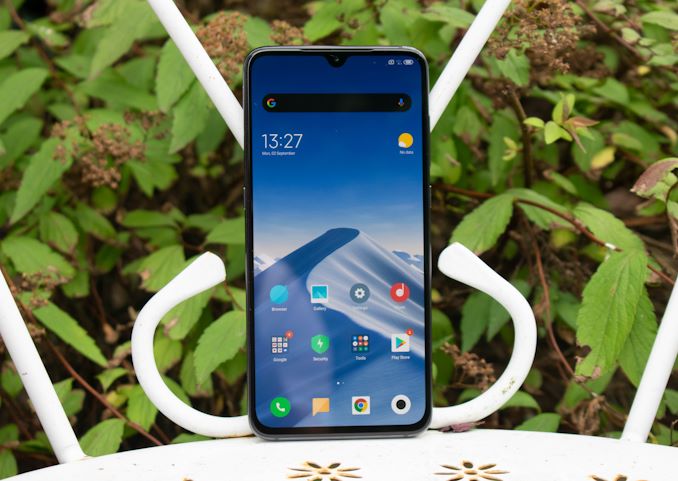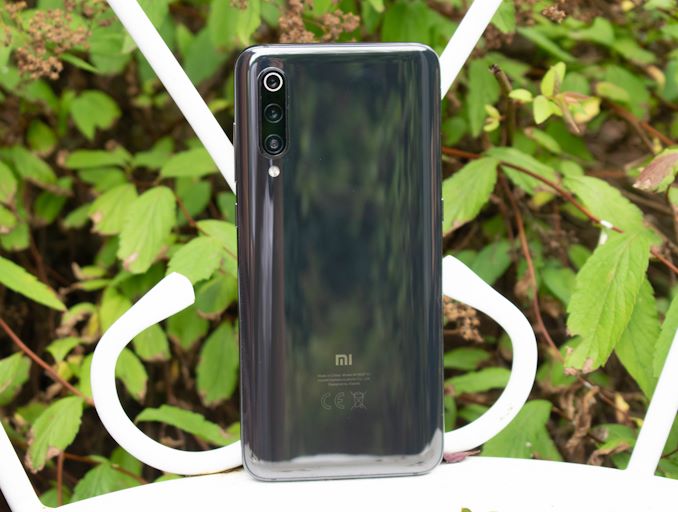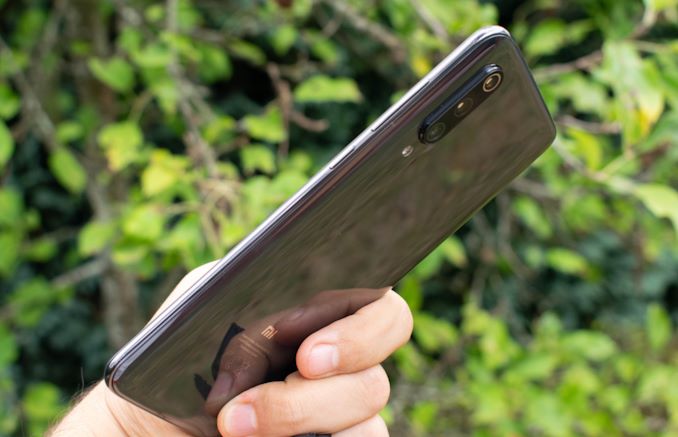The Xiaomi Mi9 Review: Flagship Performance At a Mid-Range Price
by Andrei Frumusanu on September 13, 2019 9:00 AM EST- Posted in
- Mobile
- Smartphones
- Xiaomi
- Snapdragon 855
- Xiaomi Mi9

We’re edging towards to latter half of 2019 and the next and last upcoming wave of device releases, however among the many device releases of the year one device we missed to review was the new Xiaomi Mi9. The phone was amongst the earliest releases of the year, being actually representing one of the first Snapdragon 855 devices announced back in February.
Xiaomi’s always been an interesting vendor that stood out alongside Huawei as one of the bigger Chinese vendors that have a larger presence in the west. Particularly last year and especially this year Xiaomi has made a lot of progress in terms of their push in European markets by officially releasing and offering their flagship devices in different market. The Mi9, as opposed to past iterations, thus no longer represents being a special case or import device, but rather a simple official Amazon purchase.
Today the Mi9 can be had for even less than its original 445€ launch price, being available for less than 400€, whilst still offering flagship performance, a triple camera setup, a great screen, all in a compact and attractive package. We’ll go over the device and exactly investigate how Xiaomi is able to offer such hardware at a low price, if there’s compromises and where they lie.
| Xiaomi Mi9 | ||||
| Xiaomi Mi9 | ||||
| SoC | Qualcomm Snapdragon 855 1x Kryo 485 (Cortex-A76) @ 2.84GHz 3x Kryo 485 (Cortex-A76) @ 2.42GHz 4x Kryo 485 (Cortex-A55) @ 1.80GHz Adreno 640 @ 585MHz |
|||
| DRAM | 6GB LPDDR4X | |||
| Display | 6.39" AMOLED 2340 x 1080 (19.5:9) |
|||
| Size | Height | 157.5 mm | ||
| Width | 74.67 mm | |||
| Depth | 7.61 mm | |||
| Weight | 173 grams | |||
| Battery Capacity | 3300mAh 18W charger included / 27W support |
|||
| Wireless Charging | Qi | |||
| Rear Cameras | ||||
| Main | 48MP IMX586 0.8µm pixel w/PDAF f/1.8 |
|||
| Telephoto | 12MP IMX481 1.0µm f/2.2 45° 2x zoom |
|||
| Wide | 16MP S5K3M5 1.0µm f/2.2 117° |
|||
| Extra | - | |||
| Front Camera | 20MP 0.9µm f/2.0 |
|||
| Storage | 64/128GB UFS 2.1 | |||
| I/O | USB-C no 3.5mm headphone jack |
|||
| Wireless (local) | 802.11ac Wave 2 Wi-Fi Bluetooth 5.0 LE + NFC |
|||
| IP Rating | none | |||
| Other Features | In-screen optical fingerprint sensor | |||
| Dual-SIM | 1x nanoSIM + microSD or 2x nanoSIM |
|||
| Launch / Street Price | 64GB: 449€ / ~400€ | |||
First off, hardware wise, the Mi9 is very much a flagship device in terms of its components. It’s powered by the Snapdragon 855 like many other flagships this year, representing an excellent base platform for the phone to build on.
Xiaomi bundles the SoC with 6GB of DRAM in the global models, and comes with either 64GB or 128GB of UFS 2.1 storage. Unlike many other vendors to price the higher storage tier with significant mark-up, the 128GB variant can currently be had for only 25€ more – with some listing only even being 3€ more than the 64GB variant, a great contrast to what we see from other high-end vendors out there today.
The Mi9’s display is powered by a 6.39” AMOLED screen with a resolution of 2340 x 1080. While personally I would have liked a 1440p screen, the majority of users will have absolutely no issue with the screen’s sharpness. The display is an edge-to-edge design with minimal bezels on all sides, and is characterised by having a teardrop notch at the top housing the front camera. This style of notch is common and is probably the least controversial of all implementations we’ve seen over the last 2 years.
The device’s back is a typical curved back glossy glass design with all its positives and negatives. The negatives being again that this is quite the fingerprint magnet, however Xiaomi’s ergonomics on the phone are very much fantastic and exemplary.
We find a vertical side located camera setup with triple cameras, including a regular wide-angle, zoom and ultra-wide-angle modules. The main sensor is again the common IMX586 48MP sensor that we’ve seen with essentially almost every vendor out there this year and is paired with an f/1.8 lens. The telephoto module has a 12MP IMX481 sensor with f/2.2 lens, and finally the wide-angle is an S5K3M5 16MP sensor with a f/2.2 lens with a 117° viewing angle. The noticeable feature that is lacking on all the modules here is any kind of OIS – most likely a cost-cutting measure. The lack of OIS might have also allowed Xiaomi to make the camera housing relatively more narrow and smaller than what one is accustomed to from other phones in recent years.
As mentioned, the device’s ergonomics are quite excellent and I have to say they’re among the best of device I’ve held this year. Although the phone of a larger form-factor with 6.39” screen and a device width of 74.67mm, the phone actually feels a lot smaller thanks to the very narrow and rounded frame. Even at the centre of the phone it’s only 7.61mm thick. The only compromise I see Xiaomi as having made is the relatively smaller 3300mAh battery, which competitively is a few hundred mAh below of other options in the market this year. The bonus here is that Xiaomi actually offers wireless charging on the Mi9, making it a rare feature amongst devices in this price range and definitely a bonus.
At the bottom of the phone we find the speaker grill on the right side, and symmetrical hole-cut-outs on the left side which house the bottom microphone. There’s no headphone jack here naturally – Xiaomi was amongst the first Android vendors to drop it a few years ago – still something I found unfortunate. The phone comes with a USB-C to 3.5mm adapter, which is at least more than what other vendors like OnePlus managed to offer this year. Another audio compromise on the Mi9 is that earpiece grill seems quite big and capable, it’s not being used for stereo playback, instead relying on the bottom firing speaker primarily.
On the left side of the phone we find the dual nanoSIM tray, and the assistant button below it. Xiaomi uses the Google assistant here and it works very well. The right side of the phone has your usual volume rocket button as well as power buttons. The phone also has an optical under-screen fingerprint sensor that in my experience worked quite flawlessly – it was maybe just a little slower than the implementations from OnePlus or Huawei, but it still seemed to remain faster than the ultrasonic implementation from Samsung.
Overall design wise I’m a big fan of the Mi9. It’s just such an ergonomic and no-nonsense device that I found it a rather fresh breath of air amongst other designs this year. There are some clear compromises for the phone – such as battery size, lack of IP rating or the single mono speaker, however these seem to be compromises one can live with given the price of the device.
This leads me to the question as to how Xiaomi is able to actually achieve such pricing – the company in its home market of China notably thrives on razor thing hardware margins by making profits off of their e-commerce services, but how does this play out in Europe? One way Xiaomi seems to making additional money is through ads integrated in the OS – although I love the MIUI interface and it’s an overall very clean experience, Xiaomi does show ads in instances such as when after installing application, referring to other apps such as in my experience Booking.com. This really didn’t bother me too much as it’s only ever displayed it after installing applications, but it’s something that needs mention.
















96 Comments
View All Comments
Andrei Frumusanu - Friday, September 13, 2019 - link
You're welcome to point out and name the actual tests you have problems with.Xiaomi has a history of cheating in benchmarks - I'm using obfuscated application IDs that circumvent such detection and thus the numbers published here represent the actual app performance of the phone.
Redmyth79 - Friday, September 13, 2019 - link
I would love to challenge you on that as I'm a 1st time buyer of Xiaomi being the Mi 9.Again I've owned Galaxy S4-S9+ Note 9, LG G2-G4, V20-30, IPhone 6plus-8plus yet the Mi 9 makes small work of all them including the iPhone XS Max in performance!
I also have posted my results on my YouTube which that can't be cheated as I even video recorded a AuTuTu 8.02 system test which I got 440,701 and sense then I've gotten higher.
No BSing there
Andrei Frumusanu - Saturday, September 14, 2019 - link
I accept your challenge. You play the AnTuTu card, you lose.Ian Cutress - Saturday, September 14, 2019 - link
AnTuTu is the laughing stock of benchmarks. The minute someone tries to justify their position with an AnTuTu score, you know not to take them seriously.Korguz - Saturday, September 14, 2019 - link
if you really have owned all those phones, then either, you dont take care of them, and they get broken fast, and need to be replaced, you are one of those that HAS to upgrade for no reason other then for bragging rights, or, and this is tied in with the 2nd reason, more money then you know what to do with :-)Jon Tseng - Sunday, September 15, 2019 - link
No links yet to your supposed data?Cellar Door - Friday, September 13, 2019 - link
The matter a fact here is that Andrei is the best and most technical phone reviewer for the past few years - yet here you are with anecdotal at best claims, and insulting tone.NXTwoThou - Friday, September 13, 2019 - link
I finally gave up my Lumia 950 for a Mi9 8/256 this year for less than what I paid for my 950 back in the day. Xiaomi has some really odd things that go on as they have three main roms available and the bootloader can't be unlocked for a set period of time. Once you do unlock it, xiaomi.eu uses the china beta roms and strips out the China specific things, removes all ads, and finishes translation. My phone became a whole other beast after using the weekly xiaomi.eu roms. We got moved to Android 10 August 8th. OIS, waterproofing, and a non-slippery back are the only things I feel that need refinement.MrSpadge - Friday, September 13, 2019 - link
Same here, finally switched from Lumia 950 to a Mi9. I've got two points to add:- I've toned the sharpening down one notch in the camera app, as it was producing halos around edges
- I've bought the international version after reading that the Ads can be disabled. First I had none, but after using it for 2-3 months annoying Ads started to pop up. It happens less than each day on average, but when it happens it's really annoying. You tip something and the phone does not react. Brain says "WTF" and after a short break (depending on network speed) the Ad is shown, sometimes as still image and sometimes as videos with loud sound (depending on your current setting). This interrupts the work flow and maybe also the environment and really, the least thing I'll do with whatever is advertised is to buy it. Already tried different ways to turn this off, depending on forum suggestions, but was not yet successful.
NXTwoThou - Friday, September 13, 2019 - link
I've been on .eu rom since I was allowed to unlock. The only ads I've ever seen since are very random with the built in music app and cleaner. Neither of which I use often enough for it to be an annoyance. I don't see any sharpening settings in the built in camera app. Are you using GCam?